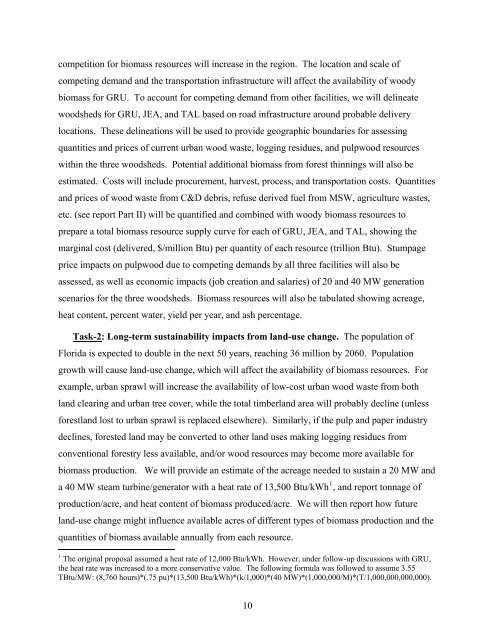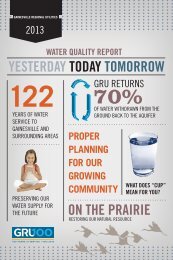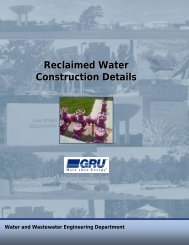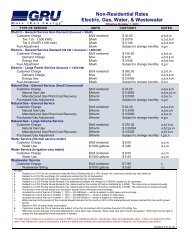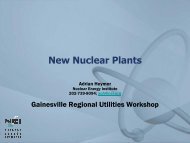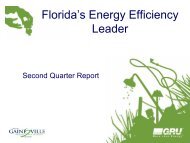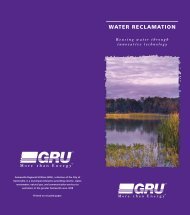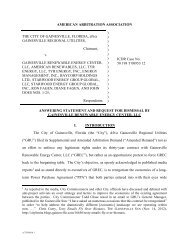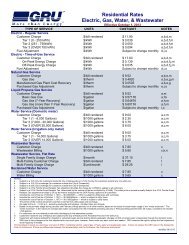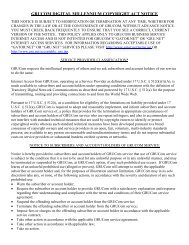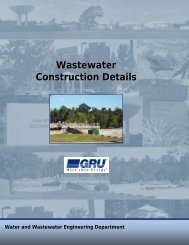Biomass Resource Assessment Part I - Gainesville Regional Utilities
Biomass Resource Assessment Part I - Gainesville Regional Utilities
Biomass Resource Assessment Part I - Gainesville Regional Utilities
Create successful ePaper yourself
Turn your PDF publications into a flip-book with our unique Google optimized e-Paper software.
competition for biomass resources will increase in the region. The location and scale ofcompeting demand and the transportation infrastructure will affect the availability of woodybiomass for GRU. To account for competing demand from other facilities, we will delineatewoodsheds for GRU, JEA, and TAL based on road infrastructure around probable deliverylocations. These delineations will be used to provide geographic boundaries for assessingquantities and prices of current urban wood waste, logging residues, and pulpwood resourceswithin the three woodsheds. Potential additional biomass from forest thinnings will also beestimated. Costs will include procurement, harvest, process, and transportation costs. Quantitiesand prices of wood waste from C&D debris, refuse derived fuel from MSW, agriculture wastes,etc. (see report <strong>Part</strong> II) will be quantified and combined with woody biomass resources toprepare a total biomass resource supply curve for each of GRU, JEA, and TAL, showing themarginal cost (delivered, $/million Btu) per quantity of each resource (trillion Btu). Stumpageprice impacts on pulpwood due to competing demands by all three facilities will also beassessed, as well as economic impacts (job creation and salaries) of 20 and 40 MW generationscenarios for the three woodsheds. <strong>Biomass</strong> resources will also be tabulated showing acreage,heat content, percent water, yield per year, and ash percentage.Task-2: Long-term sustainability impacts from land-use change. The population ofFlorida is expected to double in the next 50 years, reaching 36 million by 2060. Populationgrowth will cause land-use change, which will affect the availability of biomass resources. Forexample, urban sprawl will increase the availability of low-cost urban wood waste from bothland clearing and urban tree cover, while the total timberland area will probably decline (unlessforestland lost to urban sprawl is replaced elsewhere). Similarly, if the pulp and paper industrydeclines, forested land may be converted to other land uses making logging residues fromconventional forestry less available, and/or wood resources may become more available forbiomass production. We will provide an estimate of the acreage needed to sustain a 20 MW anda 40 MW steam turbine/generator with a heat rate of 13,500 Btu/kWh 1 , and report tonnage ofproduction/acre, and heat content of biomass produced/acre. We will then report how futureland-use change might influence available acres of different types of biomass production and thequantities of biomass available annually from each resource.1 The original proposal assumed a heat rate of 12,000 Btu/kWh. However, under follow-up discussions with GRU,the heat rate was increased to a more conservative value. The following formula was followed to assume 3.55TBtu/MW: (8,760 hours)*(.75 pu)*(13,500 Btu/kWh)*(k/1,000)*(40 MW)*(1,000,000/M)*(T/1,000,000,000,000).10


